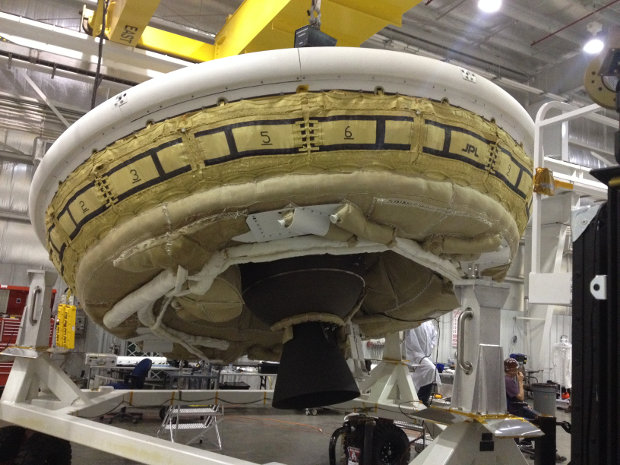
A few hours ago a prototype of a new NASA system called Low-Density Supersonic Decelerator (LDSD) which will be used to land vehicles that might be very heavy on Mars completed its first real test. A big balloon brought the prototype in the stratosphere, at an altitude of about 36,600 meters high (120,000 feet), over the Pacific Ocean. There, it was released for the test, which had only partial success due to a problem with the parachute.
The Mars landing systems have always used a parachute. In the case of the Mars Rover Curiosity, the system included other equipment that managed part of the landing. In the future, if even bigger vehicles will be sent to Mars, possibly with astronauts, we will need a proper system and LDSD is NASA’s proposal.
LDSD is a system composed of two parts designed precisely to decelerate and to allow the landing of heavy vehicles on Mars: a part composed of a donut-shaped decelerator called Supersonic Inflatable Aerodynamic Decelerator (SIAD) and a big parachute called Supersonic Disk Sail Parachute, much larger than the one used by Curiosity. A vehicle shaped like a flying saucer is used for testing.
Yesterday, the flying saucer was launched from the U.S. Navy’s Pacific Missile Range Facility. Once the balloon brought it up to 36,600 meters, its engine lifted it even more, up to about 54,900 meters (180,000 feet) to a speed of almost Mach 4, that is four times the speed of sound. This is necessary to simulate the conditions of the Martian atmosphere, as rarefied as Earth’s upper stratosphere.
According to the indications of the instruments, once at 54,900 meters high, the SIAD has been successfully deployed to decelerate the flying saucer down to Mach 2.5. It inflated and his friction allowed the first deceleration. The problem was with the parachute that wasn’t deployed correctly. Consequently, the flying saucer fell down into the Pacific Ocean at high speed instead of a controlled descent.
This was the first of three planned tests so it’s not strange that there were drawbacks. The recovery team will try to collect the pieces of the flying saucer, if something can be found after the violent splash down. The next test should take place next year, after the analysis of the data collected and the changes all’LDSD which will hopefully avoid other problems to the parachute.
Edit. Despite the speed much higher than anticipated, the flying saucer wasn’t torn to pieces and was recovered.
[ad name=”AmazonScience”]


Permalink